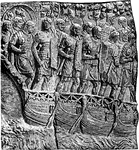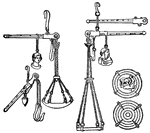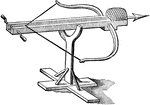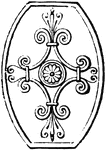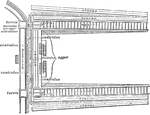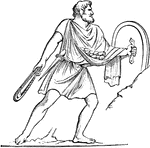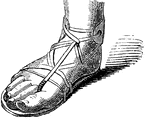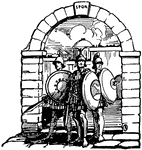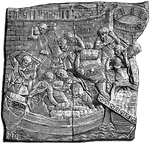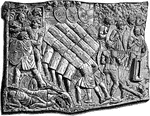This ClipArt gallery offers 396 images of the Roman Empire including culture, people, everyday life, coats of arms, and more. See also the Roman Coins, Roman Architecture, Roman Ornament, Roman Mythology, and Ancient Roman Musical Instruments ClipArt galleries.
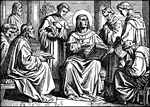
Saint Augustine of Hippo Teaches from His Writings
Saint Augustine, bishop of Hippo in Africa, sits among various other clergy and teaches from his writings.…

Sambuca
"A harp, was of oriental origin. The performances of sambucistriae were only known to the early Romans…
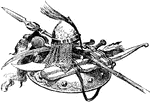
Saracen Arms
"Saracen Arms. Charlemagne now had to deal with certain non-Germanic peoples who were threatening his…

Sarcophagus of Scipio
"Sarcophagus, plural Sarcophagi, is a kind of stone used among the Greeks for making coffins, and so…
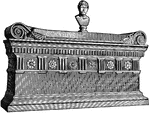
Sarcophagus of Scipio Barbatus
Sarcophagus of Lucius Cornelius Scipio Barbatus, an elected Roman consul in 298 BC.

A Section of Hadrian's Wall in Britain
A small portion of the great, Roman-built Hadrian's Wall in Britain, begun in AD 122. Two men, one sitting…
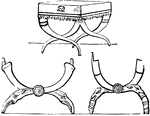
Sella
"Sella, the general term for a seat or chair of any description. Sella Curulis, the chair of state.…
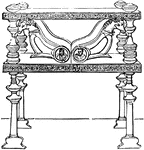
Sella
"Sella, the general term for a seat or chair of any description. Sella Curulis, the chair of state.…

Sella
"Sella, the general term for a seat or chair of any description. Sella Curulis, the chair of state.…

Sella
"Sella, the general term for a seat or chair of any description. Sella Curulis, the chair of state.…
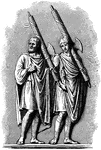
Roman Civil Servants
An illustration of two lictors, members of a special class of Roman civil servants. Lictors had special…

Alexander Severus
Roman emperor, born in Arca, in 205; slain in 235 A. D. He was of Syrian parentage and originally named…
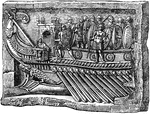
Prow of a Roman War Ship
"The representation shows the arrangement of the tiers or oars in a two-banked ship. In just what way…

Signa Militaria
"Signa Militaria, military ensigns or standards. The most ancient standard employed by the Romans is…
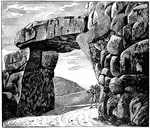
Walls of Signia
"Walls of Signia. The colony of Signia was said to have been founded by the last Tarquin; but its possession…

A Slave's Collar
"A runaway slave, if recaptured, was sometimes compelled to wear a metal collar riveted about his neck."—Webster,…
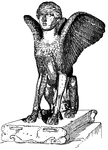
Sphinx of Lanuvium
A Graeco-Roman marble table support in the shape of a sphinx. It was found in the ruins of the Villa…
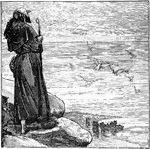
St. Columba at Oronsay
Saint Columba was an outstanding figure among the Gaelic missionary monks who, some of his advocates…

Stola
"A female dress worn over the tunic; it came as low as the ankles or feet, and was fastened round the…

Four Stringils
Four stringils in which the hollow for collecting the oil or perspiration from the body may be observed.
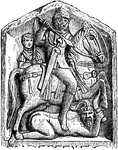
Sueve and Roman Rider
A Roman rider battling a Sueve. Suevi were Germanic people that posed a threat to the Romans.
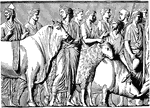
Suovetaurilia
The suovetaurilia was a sacred Roman sacrifice of a pig, a ram, and a bull to Mars, the god of war to…

Suovetaurilia
"The relief pictures an ancient Italian sacrifice of a bull, a ram, and a boar, offered to Mars to secure…
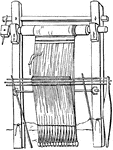
Tela
"Tela, a loom. Although weaving was among the Greeks and Romans a distinct trade, carried on by a separate…
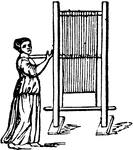
Tela
"Tela, a loom. Although weaving was among the Greeks and Romans a distinct trade, carried on by a separate…
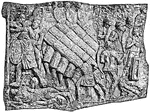
A Testudo
"A relief from the Column of Trajan, Rome. The name testudo, a tortoise (shell), was applied to the…
